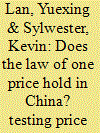|
|
|
Sort Order |
|
|
|
Items / Page
|
|
|
|
|
|
|
| Srl | Item |
| 1 |
ID:
095928


|
|
|
|
|
| Publication |
2010.
|
| Summary/Abstract |
This study examines to what extent prices diverge across China and how long it takes prices to converge following idiosyncratic shocks. We consider monthly data using disaggregated goods prices from 36 cities in China. Following [Imbs, J., Mumtaz, H., Ravn, M., and Rey, H., 2005. PPP strikes back: aggregation and the real exchange rate. Quarterly Journal of Economics 120, 1-44.], we use two estimation methods: a fixed effect method when considering goods individually and a mean group estimation specification for a panel including all goods simultaneously. The mean group method also accounts for dynamic heterogeneity across goods. Impulse response functions are obtained to calculate half-lives. With both methods, we find half-lives of only a few months or less, supporting the conjecture that convergence rates within a country are faster than rates estimated in an international context. However, the half-life reported here is still shorter than that for other studies using disaggregated intracountry data. Perhaps a lower degree of specialization and market differentiation in developing countries creates a greater potential for price convergence.
|
|
|
|
|
|
|
|
|
|
|
|
|
|
|
|
| 2 |
ID:
111086


|
|
|
|
|
| Publication |
2012.
|
| Summary/Abstract |
This paper explores price regulation and relative price convergence in the Canadian retail gasoline market. We use monthly data (2000-2010) on retail gasoline prices in 60 Canadian cities to investigate (i) whether the retail gasoline market in Canada has experienced a relative price convergence to the mean, which is expected, given the increased economic integration across Canadian provinces; and (ii) whether the introduction of price regulation mechanisms in New Brunswick and Nova Scotia in July 2006 had any impact on the price convergence in these provinces.
We use a nonlinear panel unit root test and find solid evidence that Canadian retail gasoline markets are well integrated across locales; however, the share of converging cities reveals a significant decline since July of 2006. The impact of price regulation on price convergence is mixed; our results indicate that since the enactment of the regulation in all New Brunswick cities (9) included in the dataset, gasoline prices converge to the national mean. Volatility of price is also significantly reduced. In contrast, in the wake of price regulation in Nova Scotia, all 6 cities of the province are non-convergent to the mean with increased volatility and overall price level.
|
|
|
|
|
|
|
|
|
|
|
|
|
|
|
|
| 3 |
ID:
150728


|
|
|
|
|
| Summary/Abstract |
We study time-zero efficiency of electricity derivatives markets. By time-zero efficiency is meant a sequence of prices of derivatives contracts having the same underlying asset but different times to maturity which implies that prices comply with a set of efficiency conditions that prevent profitable time-zero arbitrage opportunities. We investigate whether statistical tests, based on the law of one price, and trading rules, based on price differentials and no-arbitrage violations, are useful for assessing time-zero efficiency. We apply tests and trading rules to daily data of three European power markets: Germany, France and Spain. In the case of the German market, after considering liquidity availability and transaction costs, results are not inconsistent with time-zero efficiency. However, in the case of the French and Spanish markets, limitations in liquidity and representativeness are challenges that prevent definite conclusions. Liquidity in French and Spanish markets should improve by using pricing and marketing incentives. These incentives should attract more participants into the electricity derivatives exchanges and should encourage them to settle OTC trades in clearinghouses. Publication of statistics on prices, volumes and open interest per type of participant should be promoted.
|
|
|
|
|
|
|
|
|
|
|
|
|
|
|
|
|
|
|
|
|